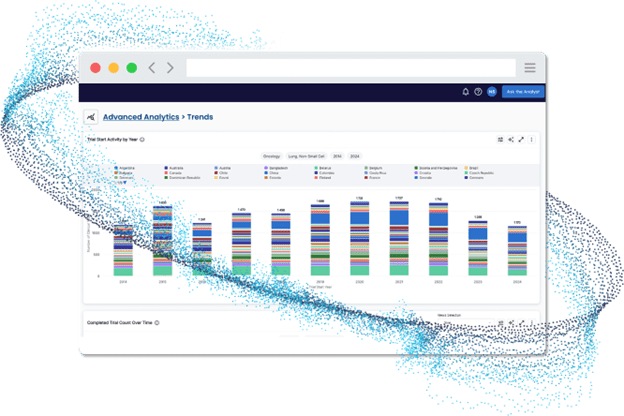Shifting Landscapes and Technologies: The State of Biotech (So Far) in 2025
Article
Clinical


Daniel Chancellor, VP of Thought Leadership at Norstella, and Claire Riches, VP of Clinical Solutions at Citeline, Riches host the podcast series “Small Biotechs, Big Decisions.” Here are a few highlights from the first four episodes.
In “Small Biotechs, Big Decisions,” a podcast series hosted by Daniel Chancellor, VP of Thought Leadership at Norstella, and Claire Riches, VP of Clinical Solutions at Citeline, Riches says the biotech industry is in uncharted waters at the moment.
“There’s a lot going on,” she says. “It’s busy, it’s noisy, you know, FDA [US Food and Drug Administration] changes, global economic crises. I mean, you name it. Everything is having some kind of influence on the pharma business at the moment. And I think some are impacting biotech more than others.”
These challenges and opportunities are the focus of “Small Biotechs, Big Decisions.” Here are some highlights from the first four episodes….

Claire Riches, Dan Chancellor
Last year, Chancellor notes, two-thirds of FDA approvals came from a biotech source. However, so far in 2025, the XBI — the main index for biotechs — is down 50% from its height during the pandemic. Funding has slowed, and IPOs for biotechs have been sparse.
“There’s no margin for error in the biotech space at the moment,” Riches says. And when funding is secured, biotechs are having to “squeeze more value out of that funding than ever before.”
Amid all this, biotech pipelines remain robust. “Biotech has always been that innovative bank that large pharma draws from,” Riches says. “And that’s still the case, absolutely. If you look at some of the big deals at the beginning of this year, they’re all around things like cell and gene therapy, precision medicine.” She notes that roughly 50% of large pharma’s revenue is coming from assets acquired from biotechs. “The biotechs are absolutely essential to feed that kind of new drug development that we see in patches in large pharma but largely is coming through M&A between biotech and large pharma.”
In her conversations with decision-makers at biotechs, Riches says one theme continues to emerge: how to do more with less. “[They say] ‘I have funding, but I need to be sure that what I’m spending my money on will give me a clear return on my investment. So, where do I develop my drug? What does my clinical development plan need to look like? What do I need to do to optimize my opportunity for M&A with pharma?’ … A lot of it is around, ‘How can we optimize the portfolio?’ but also, ‘How can we really do more with less funding?’”
Interestingly, Riches says, it’s the biotech sector that is taking advantage of tools and techniques like AI to remove white space. “It’s the white space that causes a lot of cash hemorrhaging when you’re running a clinical development plan. So, they’re looking for that efficiency.”
Chancellor cites the school of thought that suggests tough times breed innovation. “You’re forced to look to innovative, new solutions. You’re forced to trim away the fat, whether that's in your clinical development timelines, whether that’s your harnessing technology such as AI.”

Riches agrees. “A lot of the time [biotechs] have to outsource to CROs, other companies, because they just don’t have the manpower, the geographic footprint, to enable them to run those trials themselves. And that’s an expensive business…. We have been a very people-heavy business for many years, and people are increasingly expensive and prone to human error. I think the industry as a whole is getting its head around utilizing data and AI to make them efficient, obviously keeping that human lens because, ultimately, this is about patients. This is about safety.”
Chancellor says he believes a disproportionate amount of attention has been focused on using AI to discover and tweak new molecules. “I think perhaps the biggest impact will be in the less sexy but more operational [aspects] — finding patients, designing a protocol, getting your clinical trials done more efficiently, higher success rates, lower costs. That’s going to have a dramatically bigger effect on moving new drugs through to patients than shaving a couple of months off your preclinical timelines to optimization.”
According to Riches, in the present pharma climate, “me-too” assets will not make it to market, and assets that are second or third to market in their therapeutic category will not do as well. “There’s a race to the market all the time,” she says.
Competitive intelligence is all about having that edge in the market, Riches says. “The great thing is we now have access to so much data, which really gives us much more visibility into that kind of competitive landscape.”
“It’s not a zero-sum game either,” Chancellor adds. “I think if each company is doing their landscape and their competitive intelligence correctly, then each company is creating a bigger pocket of space in which they can operate, in which they can differentiate from drugs that are on the market in terms of what’s coming through from the pipe. When done very well, when being cognizant of the competition, it allows the benefits of all stakeholders — the companies that are doing it, but certainly the patients if we bring more therapies through to market that are differentiated and have a meaningful impact.”
“The uniqueness that is required these days from new assets has never been greater,” Riches says. “And that’s great, because it really pushes the boundaries and advances medicine.”
Chancellor notes there are an estimated 24,000 drugs in active development globally, a nearly 150% increase since 2010. And close to 7,000 companies are involved in RNA development, a 250% jump.
“Much of this growth has actually come from outside the traditional hotspots,” he says. “China is now nearing us in terms of its ability to create new drugs at scale. Also in Asia, South Korea has overtaken the traditional world-leading long heritage of the UK and Switzerland. … All of this is creating a lot of competition for finding patients to enroll into clinical trials.”
Riches agrees that over the last 15 years patient recruitment has become even more challenging. “I think that, ultimately, the landscape is congested.”
Riches says she views the rise of players like China and South Korea as a good thing. “We’ve long known that countries like China have been early adopters of AI and use of data. So, we need to, as an industry, utilize what we have at our disposal to really make the landscape more favorable from a competitive intelligence perspective, but also to optimize things.”
Riches suggests some ways in which competitive intelligence like real-world data can be used is in making protocols more accessible for patients, “so patients, healthcare practitioners, and investigators aren’t so burdened when it comes to running trials.
“[Trials are] hard things to run. They’re complicated. So, utilizing methods of data collection like synthetic data, synthetic arms to remove placebo controls from trials, straight away, in a lot of trials, you’re reducing patient count by probably around 50% and maybe making it much more attractive for a patient to go on a trial, because they know they’re actually getting a drug, as opposed to … a placebo.”

So far in 2025, there have been many changes in the policy landscape for pharma. The US has a new administration and new leaders installed at the FDA and Department of Health and Human Services (HHS) who, as Chancellor says, “are moving very quickly to change the status quo.” Most Favored Nation status is back in the trade conversation, and there have been tweaks to the Inflation Reduction Act. Plus, tariffs are being implemented by the US on some countries, and those tariffs have been reciprocated in many cases.
Chancellor notes these changes are layered on existing dynamics that may not yet be fully digested by the market: European pharma reform, changes to Medicare Part D, and the negotiation of maximum fair drug prices in the US.
Riches did sound one note of caution. “If the FDA really does what it says it’s going to do and trim head count but become more efficient, then great. That is fantastic. But you’ve lost a lot of intelligence there, a lot of SMEs. And our industry is very SME-heavy, and it needs to be because we’re developing new medicines and putting them in patients, and we need to be 100% sure that that things will go well from a safety perspective.”
Riches says she believes factors such as tariffs will hit the large pharma side more than biotechs. “Not many biotechs take their drug to market themselves. [But] how that will bear out for large pharma in terms of what it costs them versus then what have they got to spend on things like M&A and partnerships with bringing new biotechs along that clinical development pathway, I think, is still to be seen.”
Riches notes that in the face of the US changes, a lot of countries are working to make themselves more attractive to companies looking to conduct clinical trials. “We’re seeing a lot of companies going into places like Australia, for example, to do their first-in-human trials … .”

When it comes to prioritizing decision-making during these uncertain times, Riches advises biotechs to do their research. “Take your data, look at what it’s saying, find a thought partner who can help you with that competitive landscape, with what’s going on with various regulatory agencies.”
Since the FDA has expressed comfort with the use of real-world data and real-world evidence and synthetic arms, Riches says that’s an opportunity for biotechs to lean into those tools. “The opportunity is there, the framework is there, and it will save you time, it will save you money. And it will bring those assets either to market quicker or to the interest of large pharma, who are really scouring the landscape at the moment to restock their pipes with huge patent cliffs coming up.
“Anyone who's developing an innovative medicine in an innovative way is going to be a winner at the end of the day.”

Daniel Chancellor
VP of Thought Leadership, Norstella
Daniel has more than 15 years of experience in the biopharma industry, spanning roles in drug discovery, market analysis, competitive intelligence, and strategic consulting. Beginning his advisory career at Citeline, Daniel now oversees the thought leadership program for Norstella and its constituent companies, producing materials that support clients across a range of hot topics in the biopharma industry. As part of this, Daniel regularly participates in webinars, conferences, and other speaking arrangements, and he has provided expert insights across a wide range of leading industry and business publications. Prior to joining Citeline, Daniel worked as a medicinal chemist at the UK biotech company Summit Therapeutics and graduated with First Class Honors in Natural Sciences from the University of Bath.

Claire Riches
VP of Clinical Solutions, Citeline
Claire recently joined Citeline with an extensive and impressive background with over 25 years’ experience in the Pharma industry within both clinical research and commercial strategy. Claire’s broad career encompasses multiple clinical fields: project management to client engagement and Business Unit head to Therapeutic Area Lead in large CROs. In her most recent role at Syneos Health, Claire acted as SVP, Global Client Solutions leader responsible for key Top Pharma relationships in the EU. Claire now works closely across the Norstella extended Commercial leadership team, solution consulting, Citeline sales, clinical product strategy, and other key functions at Citeline.


